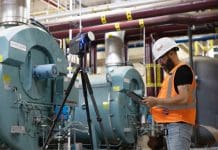In this article, Jason White, divisional director of operations at Assent Building Control explains to PBC Today the future of commercial construction ahead of the Future Buildings Standard
In December 2021, the Department for Levelling Up, Housing and Communities (DLUHC) published the outcome of the Future Buildings Standard consultation. The document outlined the second stage of a two-part review on changes to the Building Regulations to help decarbonise the UK’s building stock. It followed the 2019 Future Homes Standard consultation, which set out stricter energy guidance for new residential properties.
The Future Buildings Standard proposes changes to Part L and Part F of the Building Regulations, which cover fuel and power conservation and ventilation in new non-domestic structures. It also sets out the government’s vision for highly efficient buildings, powered by low-carbon heat. The consultation’s proposals also include:
- The introduction of the Future Buildings Standard for new non-domestic buildings from 2025.
- An interim uplift to energy efficiency standards to reduce carbon emissions by 27% in non-domestic buildings. In theory, this uplift will give construction professionals and supply chains time to prepare for wider reforms in 2025.
- Improvements to non-domestic energy modelling methodologies.
The alterations demand extensive upskilling, materials upgrades and process changes across an already strained supply chain. With the countdown to compliance already in motion, how can the construction sector meet the Standard’s ambitious sustainability requirements – and how can building control speed their progress?
A low-carbon future for commercial construction
Traditionally, the shift to greener housing stock has taken centre stage. After all, homes account for 16% of the UK’s total carbon emissions, generally due to poor insulation and central heating systems fuelled by non-renewable resources. However, the Future Buildings Standard will shine a light on the decarbonisation of non-domestic buildings – from offices to warehouses to hotels.
From 15 June 2022, new commercial buildings will be required to produce 27% fewer carbon emissions in comparison to existing buildings. Improvements will also need to be made to increase ventilation, boost air quality and cut transmission risks of airborne viruses. The reforms are an important practice run in advance of the Future Buildings Standard’s (FSB) more stringent demands, set to come into force in 2025.
Under the new framework, heat pumps, heat networks and sustainable materials will be key to cutting emissions across non-domestic buildings. The goal is to create zero-carbon-ready buildings by transforming energy efficiency and making low carbon heat the go-to option for all new structures. The move will future-proof developments as the grid decarbonises, eliminating expensive fixes and retro-fit requirements down the line.
The next consultation of the Future Buildings Standard is due in 2023 and is expected to cover technical details and draft guidance. In the meantime, the construction industry is under immense pressure to plan, prepare and perform under developing guidelines.
Sector-wide sustainability goals
Currently, the UK construction industry consumes resources in a way that is not sustainable. Many contractors have made commitments toward more responsible operations and project delivery – but compliance under the new rules is a sizeable challenge.
Achieving success in sustainable construction requires a delicate balance of social, environmental and economic principles. In other words, upholding the three pillars of people, planet and profit. While it’s a big ask for a sector beset by materials and skills shortages, a coordinated effort could make it possible.
Setting clear, common goals will help the industry plot an achievable course towards carbon-neutral construction.
-
Sourcing renewable and recyclable resources
As we make our way towards net-zero, materials will have to work harder than ever before. The FBS advocates low-carbon technology to keep buildings warm – but it actively champions fabric-first heat retention. Even in the face of stock deficits and sourcing issues, the industry needs to prioritise sustainability at every stage, opting for responsible supply chains and renewable, recyclable and local resources.
2. Reducing waste
Working together will reduce wastage and shape the sector around shared ideals. By reusing materials – from plasterboard, plastics and metals to aggregates, glass and wood – construction professionals can cut costs, close the loop and divert usable resources from landfill.
3. Embracing greener construction techniques
Modular building and offsite construction allow structural elements to be created in a controlled, quality-checked environment. The speedy, cost-effective process produces less waste and requires less energy, fuel and machinery.
Collaboration is critical
For sustainable principles to work in practice, the industry needs to adopt a team mentality – and fast. The clock is ticking on FSB compliance, with interim Plan L and Plan F requirements going live within weeks.
To prevent penalties and build with the bigger picture in mind, designers, developers, construction crews and building control professionals must pool expertise from the outset of every project.
Enjoy the benefits of early collaboration
The choice of sustainable techniques and materials is significantly broader at the beginning of any project. Invite every key contributor – from architects to building control – to discuss priorities and practices at design stage. Tap into each team’s knowledge to evaluate, compare and select carbon-reducing components from the widest possible range of options.
Think sustainability from the start
Align green goals across the entire team and work as one unit to weave in compliance and sustainability measures from the project’s first stages. This shared sense of ownership and accountability will cut the odds of costly changes once the build begins.
Get expert guidance on evolving regulations
Work with building control throughout the project to keep design and construction in line with changing requirements. In addition to locking in compliance at every key milestone, a trusted building control partner can also highlight lesser-known efficiency solutions to boost sustainability levels.
The Future Buildings Standard sets the parameters for new non-domestic buildings to produce fewer carbon emissions. As a preview, the imminent uplifts to Part L and Part F will give construction professionals a glimpse of farther-reaching requirements – and opportunities – to come.
As an industry, we have a collective responsibility to continually improve practices and reduce CO2 emissions. Careful planning, management and design all have a key part to play in sustainability, and success will come from a sector-wide approach.
Jason White
Divisional director of operations
Assent Building Control
Twitter: @assentbc














